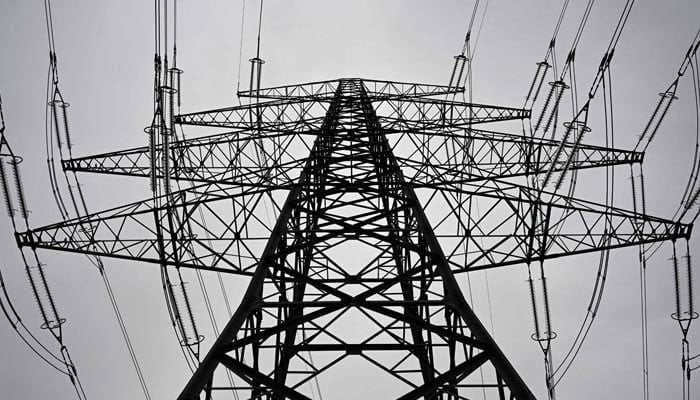
ISLAMABAD: Pakistan and the International Atomic Energy Agency (IAEA) signed a new six-year Country Programme Framework (CPF) on Wednesday, strengthening cooperation in peaceful nuclear applications ranging from food security to energy and healthcare.
The fifth CPF, covering 2026–2031, was signed on the sidelines of the IAEA General Conference in VIENNA, Austria, by Dr. Raja Ali Raza Anwar, chairman of the Pakistan Atomic Energy Commission (PAEC), and Hua Liu, IAEA deputy director general and head of the Department of Technical Cooperation.
The framework identifies five priority areas: food and agriculture, human health and nutrition, climate change and water resource management, nuclear power, and radiation and nuclear safety. It aligns with Pakistan’s development goals and the UN Sustainable Development Goals (SDGs), while covering three IAEA technical cooperation cycles.
Agriculture, which makes up nearly a quarter of Pakistan’s GDP, will see expanded use of nuclear techniques to boost crop yields, enhance pest control, and improve livestock health. In health, the CPF focuses on expanding nuclear medicine and radiation oncology services across the country’s 20 Atomic Energy Cancer Hospitals, which already treat more than a million patients annually. With Pakistan among the most climate-vulnerable nations, nuclear techniques such as isotope hydrology will help manage water resources and adapt to changing weather patterns. In the energy sector, where nuclear contributes over 18 per cent of annual power generation, the CPF emphasizes safe plant operations, waste management, and life-cycle planning.
“The signing of this Country Programme Framework reaffirms Pakistan’s unwavering commitment to the peaceful applications of nuclear science and technology,” Dr. Anwar said. “With the support of the IAEA, Pakistan will continue to harness these tools to address food security, improve healthcare, strengthen energy security, and safeguard our environment.”
Liu called the agreement a “shared vision for sustainable development through peaceful nuclear cooperation.”

Holder pasteurization fosters richer gut microbiomes in preterm infants, closely mimicking the benefits of mothers’ own milk, while Retort processing appears to diminish key protective bacteria.
Impact of donor human milk pasteurization methods on the gut microbiome of preterm infants. Image Credit: RMC42 / Shutterstock
In a recent study published in the journal Pediatric Research, researchers at Vanderbilt University Medical Center in the USA investigated the impacts of two typical donor human milk (DHM) treatments, Holder and Retort, on infant gut microbiomes. The study leveraged a cohort of pre-term infants (n = 150) fed either Holder- or Retort-pasteurized donor human milk (DHM) and prospectively collected weekly stools but analyzed one stool per infant to evaluate the impacts of the two donor human milks (DHMs) on gut microbiota.
Study findings highlight the importance of heat duration and temperature in maintaining milk quality, revealing that infants receiving Holder-pasteurized milk exhibited significantly higher gut microbial diversity and a greater abundance of beneficial bacteria. Notably, Holder-pasteurization resulted in a microbiome that more closely resembled that of infants fed their own mother’s milk.
The first few months of life are a crucial period of infant growth and development. Human (mother’s) milk is the established gold standard for infant nutrition, providing the optimal balance of nutrients and bioactive factors to support healthy growth and immune development during this critical period. It contains a unique blend of nutrients, antimicrobial proteins, antibodies, human milk oligosaccharides, and other immune-protective compounds that promote gut maturation, shape the developing microbiome, and reduce the risk of infections, inflammatory conditions such as Necrotizing enterocolitis (NEC), and other serious neonatal complications.
Early life nutrition is particularly relevant to pre-term infants in the Neonatal Intensive Care Unit (NICU). When a mother’s own milk (MOM) is insufficient, pasteurized donor human milk (DHM) is the recommended alternative. However, unlike breastfed MOM, DHM must be treated to eliminate harmful pathogens and ensure its safety to immunocompromised infants.
The two most common methods of DHM treatment are Holder pasteurization (heating milk to 63°C for 30 minutes) and Retort pasteurization (heating milk to 121°C for 5 minutes at ~15 PSI). While both are effective, the harsher Retort method is hypothesized to degrade more of the milk’s beneficial bioactive components.
Unfortunately, the impacts of these treatments on infant gut microbiota, a crucial determinant of long-term physiological and developmental well-being, are unknown.
The present study aims to address this knowledge gap and inform pediatricians and parents by directly comparing the impacts of the two pasteurization methods on the gut microbiota of a large cohort of pre-term infants at the Vanderbilt University Medical Center.
Notably, the NICU at Vanderbilt had used Retort-pasteurized DHM from December 2019 to March 2022 due to pandemic-related supply shortages, but then switched back to their standard Holder-pasteurized DHM, unintentionally generating the ideal sample group for the present investigation.
The study analyzed one stool sample per infant collected once they were on exclusive full-volume DHM for at least a week, from 150 pre-term infants born at less than 34 weeks’ gestation. The infants (study participants) were divided into three groups based on their exclusive diet: 1. Retort-pasteurized DHM (n = 80 infants), 2. Holder-pasteurized DHM (n = 54 infants), or 3. Their own mother’s milk (n = 16 infants). Antibiotic exposure was much lower in the MOM group (18.8%) than in either the DHM group (~80%), and the Retort group had a higher C-section delivery rate (82.5% vs. 64.8% in the Holder group).
Whole-metagenome sequencing (WMS) was used to identify and characterize all the microorganisms present in the stool samples, thereby assessing the diversity and composition of the gut microbiome and elucidating its functional capabilities.
WMS analyses revealed significant differences in the gut microbiomes of infants depending on the type of milk they received, particularly in terms of microbial diversity. Infants fed Holder-pasteurized DHM demonstrated significantly higher alpha-diversity, a key measure of a healthy, rich ecosystem, than their Retort-pasteurized DHM-fed counterparts (Chao-1 index, p = 0.007). Shannon diversity did not differ significantly, and beta-diversity analyses revealed that diet and delivery mode had a significant influence on microbiome composition.
Notably, observed diversity differences were driven by the abundance of specific beneficial anaerobic bacteria known to support gut health, including Bacteroides thetaiotaomicron, Clostridium species, and Bifidobacterium species. In contrast, these beneficial microbes were less abundant in the Retort group. Functional profiling revealed enrichment of genes involved in carbohydrate metabolism and sugar transport systems, including ABC transporters and phosphotransferase systems, in infants fed with Holder’s formula.
Comparisons of data from infants fed MOM revealed that the microbiome of the Holder-fed infants was much more similar to that of infants fed their mother’s own milk, suggesting the gentler pasteurization method better preserves the components of human milk that help cultivate a healthy gut.
However, despite these profound microbial differences, the study found no statistically significant variations in short-term clinical outcomes, including NEC, bronchopulmonary dysplasia (BPD), intraventricular hemorrhage (IVH), mortality, or length of hospital stay between the two DHM groups. However, retinopathy of prematurity (ROP) was lower in the MOM group than in either the DHM group or the control group.
The article provides the first direct evidence demonstrating that the method used to pasteurize donor human milk has a measurable and significant impact on the gut microbiome of pre-term infants. It highlights that the gentler Holder pasteurization process results in a more diverse and beneficial microbial community, closely mimicking the effects of the gold-standard mother’s own milk.
The authors note that the single-timepoint design and limited sample size may have reduced power to detect clinical outcome differences, and that group differences in delivery mode and antibiotic exposure could have influenced the results. Nevertheless, these pre-term infant microbiome findings represent a crucial step forward in safeguarding this nutritionally vulnerable subpopulation.
Journal reference:

ISLAMABAD: The federal government is working with the International Monetary Fund (IMF) and the Finance Ministry to finalize a relief package for flood-affected electricity consumers, which will be announced within the next 24 to 48 hours, the National Assembly’s Standing Committee on Energy was told Wednesday.
Power Division Secretary Fakhar Alam Irfan said the package, aimed at easing the burden of electricity bills in disaster-hit areas, is being shaped in consultation with both the IMF and economic managers in Islamabad. “In a day or two, we will bring a relief plan for affected consumers,” he told the committee.
The announcement came as lawmakers during the parliamentary panel meeting held with MNA Muhammad Idrees in the chair, grilled Hyderabad Electric Supply Company (Hesco) over chronic governance failures, low bill recoveries, and unannounced load-shedding. Irfan noted that distribution companies in Lahore and Multan had achieved up to 100 percent recovery, while Hesco continued to lag. “It is not about honest officers sitting in Lahore or Multan,” he said. “Hesco’s problem is governance, not capacity.”
The issue of power outages sparked heated exchanges. Committee member Syed Hussain Tariq demanded an explanation for blackouts when regulators had allowed seven to eight hours of scheduled load-shedding. Hesco’s chief executive admitted unplanned outages occurred due to operational problems, drawing sharp criticism from lawmakers.
Detailing sector finances, Irfan said the power sector recorded losses of 397 billion rupees last year, compared with a target of 640 billion rupees. Losses for the current fiscal year have been capped at 540 billion rupees, with both the IMF and Prime Minister acknowledging progress.
Irfan added that Hesco and Sukkur Electric Power Company (Sepco) would not be privatized but handed over on concessionary contracts to improve recoveries, a model successfully used in Turkey. Their boards will soon be restructured with a majority of private-sector members.

Getting out of bed in the morning without the risk of passing out is a game-changer for 32-year-old Cody Krebs.
In 2022 Krebs experienced a severe spinal cord injury (SCI) in a motor vehicle accident. Since that time, Krebs requires the use of a wheelchair. The damage to his spinal cord means his brain can no longer control blood pressure in his body. He was vulnerable to blood pressure drops where he was at risk of losing consciousness, and spikes placing him at risk of a heart attack and stroke. However, an international clinical trial led by teams at the University of Calgary, École Polytechnique Fédérale de Lausanne (EPFL), and University of Lausanne (UNIL), in Switzerland, and Sint Maartenskliniek, Radboudumc, in the Netherlands has given him control again.
“Before the accident, I had no idea how volatile blood pressure can be. Just transferring from my bed to my chair almost knocked me out at times when my blood pressure would drop,” says Krebs. “At other times during the day, my blood pressure would spike due to severe nerve pain, causing me to break out in a sweat and experience severe migraines.”
Krebs is part of ongoing research at the University of Calgary based on a major discovery to stabilize blood pressure for people with SCI.
In a rare double publication in both Nature and Nature Medicine, a pair of landmark studies by Dr. Aaron Phillips, PhD, UCalgary, Dr. Grégoire Courtine, PhD, EPFL, and Dr. Jocelyne Bloch, MD, UNIL, describe the development of a targeted therapy to address blood pressure regulation in 14 participants across four clinical studies conducted at three separate medical centers in Canada, Switzerland, and the Netherlands.
The study participants and Krebs now have an implantable system on their spine consisting of a new class of electrode arrays. These arrays connect to a purpose-built pulse generator-similar to a cardiac pacemaker-that delivers finely tuned electrical stimulation, calibrated to each person’s needs. The result is a compact, adaptable system capable of restoring blood pressure stability through targeted neuromodulation that can be controlled through an app.
“Our mechanistic discoveries in Nature were crucial in bridging the gap from foundational neuronal mapping to clinical application. This synergy is what allowed us to move so quickly from theory to therapy,” says Phillips, director of the RESTORE Network and associate professor at the Cumming School of Medicine. “The Nature Medicine study demonstrates several important factors. First, we show that low blood pressure after a spinal cord injury has serious medical consequences that must not be clinically ignored. Second, we show that our neuromodulation therapy for blood pressure instability after SCI can be deployed effectively in diverse clinical settings, at several centers in different countries with different medical protocols.”
Phillips adds the Nature paper also showed that long-term use of the therapy treats not only the low blood pressure occurring after SCI but also prevents the development of life-threatening spikes in blood pressure.
“In the Nature study we were able to identify the entire neuronal architecture of the spinal cord that is responsible for uncontrolled, life-threatening elevations of blood pressure, called autonomic dysreflexia. We also showed that spinal cord stimulation can compete with this neuronal architecture to safely and precisely regulate blood pressure,” says Courtine, director of NeuroRestore Center and professor at EPFL.
The results were consistent in study participants across all sites: once activated, the system restored blood pressure to a functional range, often within minutes.
“Based on our experiences with this novel treatment, participants report experiencing less brain fog, having more energy, being able to speak louder, and suffering less from a postprandial dip. In addition, once the surgery was performed by neurosurgeon Erkan Kurt at Radboudumc, this system proved relatively easy to use in their home environment,” says Dr. Ilse van Nes, MD, PhD, who successfully deployed the system at the rehabilitation center Sint Maartenskliniek in Nijmegen, Netherlands.
“The international deployment shows that the surgery and therapy are safe and effective regardless of local practices. It’s a key milestone toward making this technology widely available,” says Bloch, neurosurgeon at Lausanne University Hospital.
While much of the focus in SCI care has been on restoring movement, a majority of patients live with chronic hypotension, a condition that leaves them exhausted, cognitively dulled, prone to fainting, and predisposes to cardiovascular disease over the long-term.
“The implanted devices have a robust safety profile, as they are commonly implanted in the treatment of various pain disorders,” says Dr. Fady Girgis, MD, neurosurgeon at the Foothills Medical Centre. “Therefore, it’s an easy transition to implant them for this novel indication. We’ve seen very impressive and immediate improvements in blood pressure that are evident as soon as the device is turned on intra-operatively.”
Krebs says he’s proud to be in a clinical trial advancing discoveries in this field. “It feels good to be able to boost my blood pressure when I need to, I have more energy and am thinking more clearly. Also, there are fewer dangerous spikes in my blood pressure. I am very grateful for all the research being done.”
The implantable neurostimulation system evaluated in these studies was developed by ONWARD Medical. ONWARD Medical has recently received FDA approval to initiate a pivotal trial of this therapy, which is expected to involve approximately 20 leading neurorehabilitation and neurosurgical research centers across Canada, Europe and the United States.

11 athletes from the Centre of Excellence will travel to Abu Dhabi next week for the NBA Academy Showcase.
Attending from the COE; Nash Walker (TAS), Che Brogan (VIC), Marcus Vaughns (VIC), Ajak Nyuon (ACT), Flynn Pavely (NSW), Alex Dickeson (SA), JK Mach (WA), Guer Bar (VIC), Jai Fa’ale (VIC), Harry Cook (QLD), Luke Paul (WA).
The NBA Academy Showcase is a unique opportunity for some of Australia’s best talent to compete against other international academies.
COE will play fixtures against IMG Academy Ascender Elite (Florida, USA), INSEP (Paris, France) and NBA Global Academy Africa (Saly, Senegal) from 25 – 27 September.
Robbie McKinlay, Men’s Head Coach at the COE will lead the group with Braden Cotter in support.
“The NBA Academy Showcase provides our young players with another opportunity to compete against elite international competition,” said McKinlay.
“The event allows us to compete against competition from three continents and also provides valuable exposure for the athletes. The UAE is a thriving basketball country so we are excited to be part of the event and experience the culture,” he added.
Abu Dhabi Showcase | Schedule
Thursday, September 25
|
Centre of Excellence (AUS) |
IMG Academy Ascender Elite (U.S.) |
|
NBA Academy (AFR) |
INSEP (FR) |
Friday, September 26
|
IMG Academy Ascender Elite (U.S.) |
NBA Academy (AFR) |
|
INSEP (FR) |
Centre of Excellence (AUS) |
Saturday, September 27
|
NBA Academy (AFR) |
Centre of Excellence (AUS) |
|
IMG Academy Ascender Elite (U.S.) |
INSEP (FR) |

Eva Longoria turned heads in New York City this week, not just with her fashion, but with her candid insight into the emotional ride behind her latest project.
Back in the U.S. to promote ‘Necaxa,’ her new docuseries about owning a Mexican soccer team, the actress and producer appeared on Good Morning America, where she revealed a stark piece of advice she got from one of her fellow investors, Ryan Reynolds.
“They said prepare for heartbreak,” Longoria shared. “’Cause sports is so emotional, with all the ups and the downs. It is an emotional roller coaster.” Longoria co-owns Club Necaxa, a Mexican soccer team she’s been working to revitalize, a journey the series documents in full.
The project follows the high-profile Wrexham story led by Reynolds and Rob McElhenney, who, notably, are also investors in Necaxa. But this time, the spotlight is on Latin American football, and Longoria is leading the charge.
As she made her way to Late Night With Seth Meyers, Longoria was photographed in Midtown Manhattan wearing a striking white asymmetrical dres, proving once again that she’s unafraid to break the “no white after Labor Day” rule.
The dress featured a structured mockneck top, a sleek bodice, and a flowing pleated mesh overlay that gave movement and dimension to her silhouette. She completed the monochromatic look with pointed white heels, subtle gold jewelry, and a polished beauty look, which included mauve lips, glowing skin, and her signature caramel-highlighted hair worn down.
It was a sophisticated, fashion-forward look that matched the seriousness and emotional weight of her new role as a team owner trying to drive transformation both on and off the field.
While her return to the U.S. is tied to the launch of Necaxa, Longoria has been living primarily overseas with husband José Bastón and their son Santiago, splitting time between Spain and Mexico.
After purchasing a home in Marbella in 2023, the family made a full move abroad in 2024, a decision she has described as deeply personal and not politically driven, despite public speculation.
As for her iconic role on ‘Desperate Housewives,’ she hasn’t lost her sharp wit. “Oh Gaby? She’d be an influencer,” she joked during her interview. “She probably would have been the original fashion influencer.”
“And Bree too,” she added. “Bree would have probably been the first Martha Stewart.” And when reminded the series began 21 years ago, she said, “21 years… and I look the same,” Longoria laughed. “No, but it was one of the best times in my life and I have such fond memories of the show.”